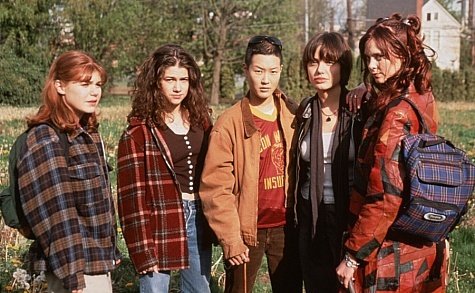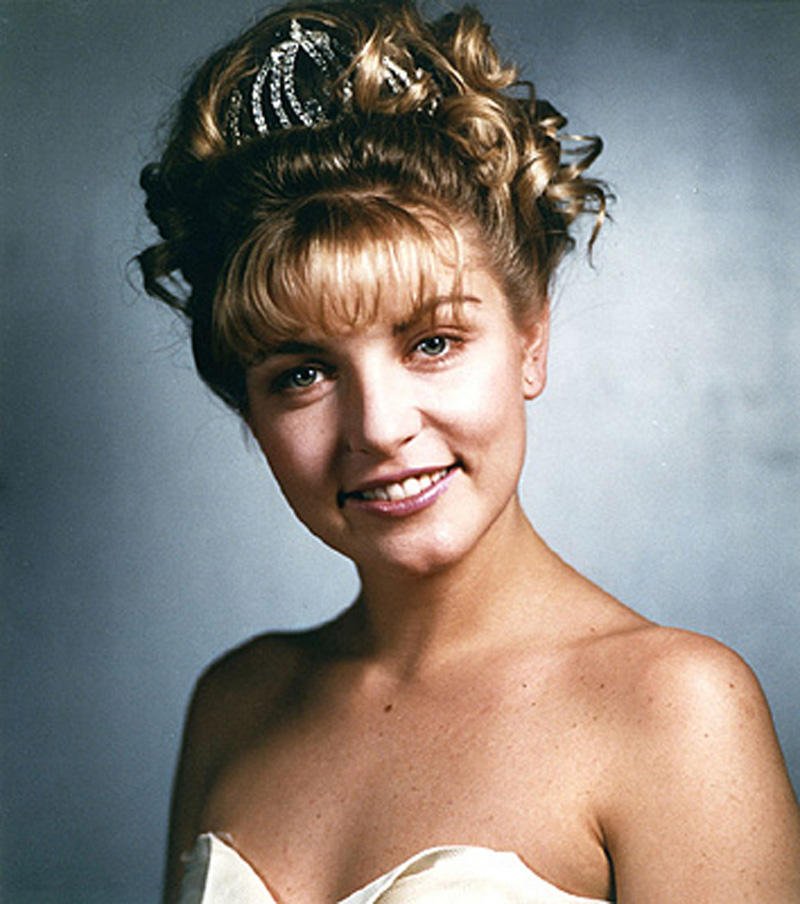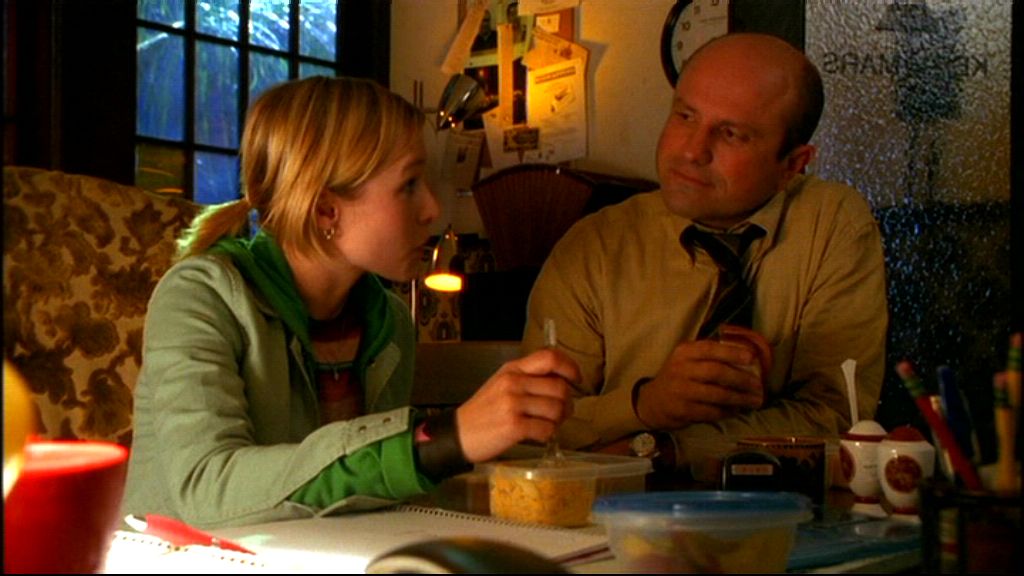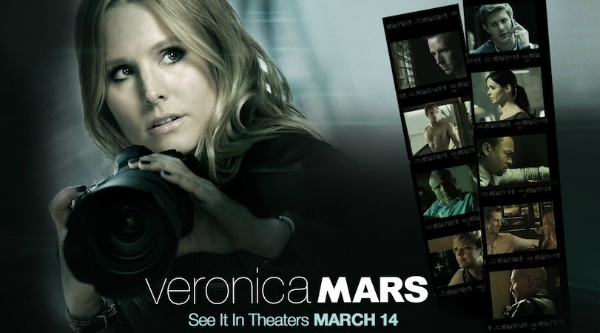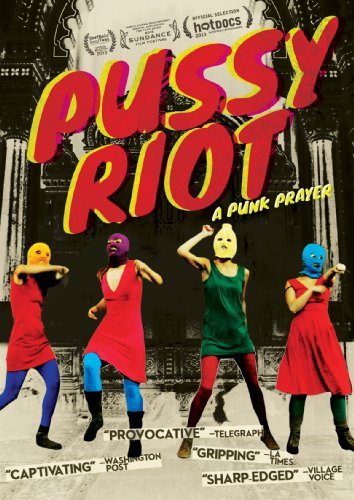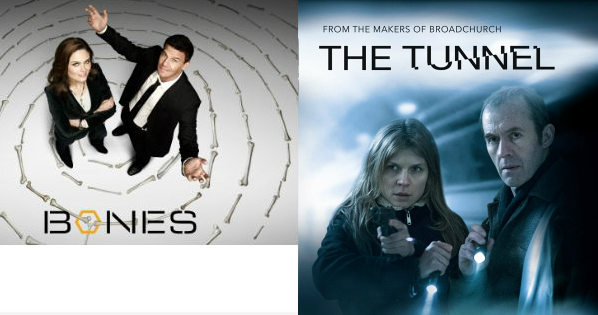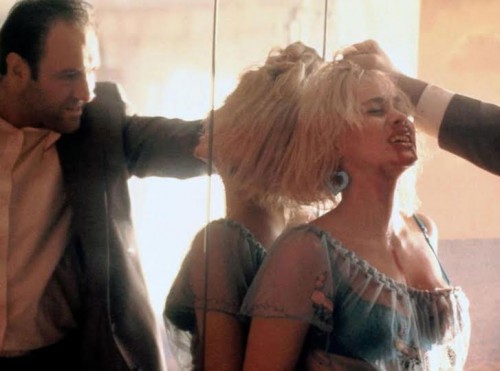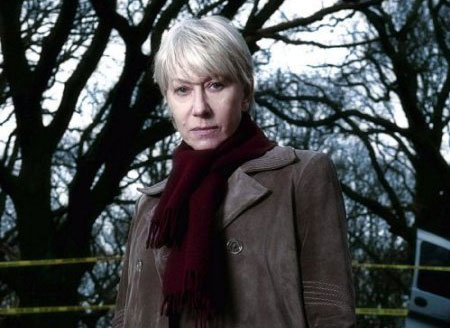Written by Elizabeth Kiy as part of our theme week on Rape Revenge Fantasies.

Though very different, the two films based on Joyce Carol Oates’s novel, Foxfire: Confessions of A Girl Gang, have a shared message: that rape culture is pervasive and the experiences of girls and women within it are, sadly, universal. In both films, one set in the 90s, the other in the 50s, teenage girls inhabit dangerous territory, full of sexual assaults and near misses, all ignored by the authorities around them. Their experiences aren’t considered unusual or justified within their respective narratives; instead, they point out that women are given a lot of reasons to feel unsafe and afraid in our society. At the very least, we’ve all been told not to walk home at night or to be frightened by a man following too close on our heels.
Unlike a lot of other films discussed this week, the girls of Foxfire are not avenging a particular rape, but are instead rebelling against rape culture in many forms: catcalls, description of women by only their physical attributes, slut shaming, rape and molestation, predatory authority figures and the society that allows men and their opinions more power than women.
While rape revenge films are often criticized for using rape for titillation or as a means to justify nudity and graphic violence, the ideas are invoked here to make viewers think.

In these films, one girl is mocked by a teacher for her appearance and has her intelligence demeaned. One girl is groped while another is shamed. Yet another is offered a free typewriter by her uncle in exchange for sex; a fifth is spied on in the shower. During a trial, the defendant’s promiscuity is the most important factor in deciding her guilt. And when one girl returns home after being raped, her mother’s only response is to tell her to clean herself up before her father sees.
Forming a girl gang allows the characters to stop seeing sexual assault as the problem of each individual victim, but as something that effects all of them. When one girl, Rita, thanks the group for helping her, their leader assures her that she isn’t to blame–if Rita wasn’t the victim, it would have been someone else. Women need to band together instead of shaming each other if they have any hope of changing things.
Both films center on a passionate and androgynous leader, named Legs, who mobilizes the girls, first in a series of pranks and acts of rebellion small enough that viewers can cheer them on, then through several dangerous and criminal acts, before culminating in the kidnapping of a wealthy man at gunpoint. Maddy (Hedy Burress), Legs’s closest confidant, observes the events and acts are narrator, chronicling the group’s rise and fall.
The original 1996 film, starring Angelina Jolie as Legs, is clearly a product of the 90s Girl Power movement, a period known for being overly commercialized, but it’s an earnest effort with a female screenwriter, Elizabeth White and director, Annette Haywood-Carter. It’s also an attempt to modernize the novel, about working class 50s teens in Upstate New York, relocating the story to Oregon and dressing it in grunge fashion, with topics for discussion like sexism, female disenfranchisement, parental neglect, and masturbation. However, as a mainstream film, it’s sanitized, more playful than the book and as the girls are middle or upper middle class, the stakes are less dire. Foxfire never becomes a literal gang or a lifestyle, just an episode in their lives, that facilitates their coming of age.
For the remake, director Laurent Cantet restored the novel’s setting and stuck pretty faithfully to the book, attempting to cram in all the causes Foxfire rebels against, including ageism, racism, animal rights, and economic disparity as well as sexism. Lead by a cast of newcomers, Cantet’s film takes a more cautionary tone, as Maddy’s attempt to redeem Foxfire, now remembered only for their criminal acts, by telling their history and their original noble goals.
While Legs in the remake (Raven Adamson) was a classmate of the other girls who they had known for years, in the original, she’s an outsider, a drifter who enters into their lives one day and helps them find their voices. Legs is given a grand entrance, heralded by thunder and followed as she boldly trespasses through the school halls.

Like a superhero, she arrives to save one of the girls, Rita (Rilo Kiley front-woman Jenny Lewis) who is being bullied by her teacher, Mr. Buttinger, for refusing to dissect a frog. Legs tells the student to “Make him stop,” and it’s a truly revolutionary idea, that a teenage girl could have any power over an adult. Her dream-like entrance and exit through the window, mark her as powerful and unconstrained by society’s rules, she doesn’t go to the school and Mr. Buttinger can’t punish her.
Legs is clearly marked as Other–she’s aggressive, with a leather jacket, heavy boots and swagger. As the camera pans up her body when she’s first introduced, not showing her face for several minutes, it’s clear viewers were meant to think momentarily, that she was a man. It is unclear why she goes by such a strange nickname, one usually thought of as objectifying; perhaps it is an attempt to reclaim something men have called out to her in the street.
Her relationship with Maddy is marked by obvious lesbian subtext, as they frequently flirt, confess their love for each other and share a bed, but her sexuality is never explicitly discussed. It is problematic that the character with the courage to fight against rape culture is the one given traits marked as masculine, while the girls she recruits, are mostly feminine and/or weak. It is also troubling that Legs’s suggested queerness is paired with her hatred of men, two things which are often falsely equated.

In both cases, the girls are enamored with Legs, who quickly becomes their hero and undisputed leader. In the original, they are all introduced as broad high archetypes, Violet (“the slut”), Goldie (“the druggie”), Rita (“the fat girl”) and Maddy (well-rounded and popular), characterizations which become more three dimensional as the film goes on.
When the other girls learn Mr. Buttinger has been groping Rita’s breasts during detention, they originally hold her responsible. It’s Legs’s influence that makes them realize there is no excuse for Mr. Buttinger’s behavior and no way Rita could deserve his abuse. In the remake, Legs blames Rita only for not fighting back, telling her, “It’s up to you to decide how men are going to treat you.” Rita takes this message to heart, exposing him as sexual predator by painting statements about his attraction to young girls on his car.
In the original, Legs tells the girls that the only way to stop his is to band together. During Rita’s detention, the girls gang up on him, physically assault and threaten him. Rita begins to come out of her shell, finally gaining the confidence to confront her abuser, threatening to castrate him if she ever touches her again. The next day, the girls are called into the principal’s office and suspended, despite their claims of sexual harassment, which are ignored.

Legs’s idea, that they can fight against abusive men only if they all stick together, but not as individuals, leads them to start Foxfire as their own collective, their own subculture. Before they had banded together, the girls went to the same school and had shared experiences, but cliques kept them segregated. Maddie, from her privileged perspective as a popular girl, looked at someone like Goldie as a sideshow, dismissed Violet as a slut and disdained Rita’s shyness as pathetic, and the cause of her own problems. Later, when they become friends, Goldie is hurt when she notices Maddie’s art project includes an unflattering Polaroid of her, clearly posed as someone to mock.
They begin to gather in an abandoned house in the woods, which they use to make a community and a safe space. Hanging around in the house, they become real friends and partake in typical teenage bonding practices, drinking, dancing, ogling guys, and laughing together. They cement their bond by tattooing each other’s breasts with a small flame logo, marking themselves as part of Foxfire, grouped together for life.
In the remake, the girls rent a house and live together in their own cloistered society as Legs intends to create an institution that would outlast her. The idea of a formal female gang with a manifesto, rules, ritual tattooing, criminal practices and recruitment, is an example of young women adapting masculine rough culture and altering it to suit them. Gangs are typically the province of disenfranchised youth (usually male), those neglected by mainstream society, such as racial minorities and the working class. Foxfire suggests the characters are disenfranchised as women and it is natural for them to act out against the society that oppresses them, as the men around them, in their own gangs, have been doing for years.

In the original film, rape culture is tied to sports culture, as both are posed as masculine spaces men feel women have no right to infringe on nor attempt to police. Their attack on Mr. Buttinger upset a group of jocks who respect him as the coach of their football team and they resent the girls. The boys begin harassing them, visiting their house in the woods and attempting to attack them, eventually trying to rape Maddy. Struggling to escape the jocks, the Foxfire girls steal a car and are arrested for it. At their trial, is implied that the jocks lied and blamed the girls for everything, leading to a “he said, she said” dynamic where the boys’ testimonies are taken more seriously. Legs in sentenced to juvie, while the others are on parole. For trying to dismantle rape culture and save themselves from attack, they are punished and lose Legs, the heart of the group.
There are also girls who help the jocks; one lures Maddy into an ambush, understanding the goal is to rape her, and lies at their trial. Later she gains some redemption when she confesses to the judge. Early on in the remake, the girls in Foxfire are reluctant to let Violet, a beautiful girl all the boys are crazy about, join. They decide Violet is promiscuous because she attracts male attention, without any evidence she returns their interest, and look down on her for it. In the remake, Legs’s mental state begins to deteriorate as she becomes disillusioned with her vision of women helping each other as a community after watching women fighting each other in juvie.
After juvie, both versions of Legs turn to darker, more violent acts. Narrating the remake, Maddy says the committed many crimes against men but most of their were not reported because their male victims were ashamed of having been attacked by girls. The films suggest revenge is acceptable to a certain level, where it’s exposing men who have who they know to be predators or teaching lessons to men who have wronged them, but is wrong once the focus moves away from specific individuals. When Foxfire starts targeting men in general, moving out of the area of defensible grey morality, Legs moves into villainous territory herself.

Strapped for cash, Foxfire (in the remake) begins to use its most conventionally attractive girls to bait men, luring them into secluded areas and then ambushing them and stealing money. One girl, Violet, finds she can make more by pretending the man tried to rape her and acting afraid until he gives her money to try and comfort her. Though baiting, these girls attempt to turn rape culture on its head and make it work for them. These acts are justified in their eyes as Foxfire begins to operate with the view that all men are rapists deserving punishment, even casting out any girl involved in a relationship as the enemy.
Out of the group in the original film, only one girl, Goldie (Jenny Shimizu) has a dysfunctional home life. In one scene, her father orders her into his car and hits her while her friends watch. Instead of struggling or hitting back as would be expected from the character, Goldie submits. When the girls discover Goldie has been using drugs, Legs goes to her father, demanding money to pay for rehab. When he refuses, though he can clearly afford it, she kidnaps him at gunpoint and ties him up, continuing to pressure him for money. The girls, as both teenagers and girls, would ordinarily be powerless to help Goldie, here, as in many areas of their lives, they find they can only get results through violence. In these scenes, the other girls surround her yelling that she’s gone too far.
In the end, Legs leaves town to escape arrest, as well as the loss of the other girls’ respect. These girls who had previously viewed Legs as a hero, looked at her with disgust and disappointment and admitted to being afraid of her. In the remake, we get some understanding of Legs’s family and background, as her father, an alcoholic, condemns her at her trial and refuses to let her live with him. Conversely, the original leaves Legs’s origins a mystery. She’s clearly damaged and something must have happened to make her, a teenage girl with a criminal record, no place to live, and roaming from town to town. The easiest explanation, is that she may have left home because of her own abuse and it’s easy to speculate that her anger at society, particularly fierce towards Goldie’s father, comes from projecting her own experiences onto their relationship.

Moreover, the 1996 version is framed as a coming of age story, cast as the year Legs came to town, changing everything, making Maddy question her perfect world and then disappeared never to be seen or heard from again- merely an episode in her life. But while the Maddy is central to the remake as its narrator, her observations of Legs and Foxfire’s history form the thrust of the narrative, rather than her own maturation. Both films end with the mystery of Legs’s disappearance and Maddy’s continuing obsession. In the original, Maddy’s decision not to go with Legs when she leaves town is framed as the one decision of her life she has always looked back on, wondering “what if?”
While the original film shows what happens when the leader of a group becomes an extremist or is mentally unstable, the remake suggests the whole group, excluding Maddy who defects, has begun to reject the rules and laws of society. Toward the end, most of the other girls are excited by their efforts at baiting and see Foxfire as one big, dangerous game that allows them to reject the limiting framework they grew up in. For her part, Legs always means well, trying, in the only way she understands, to help her friends and women as a whole.
Both endings are bittersweet. Foxfire disbands and the girls stop fighting for their causes, but they’ve helped some people and made their mark. But Legs is gone and it’s uncertain what ideas viewers are meant to come away with. It’s tricky to judge, as the films are full of feminist ideas and urgings for female empowerment, yet have dark endings where characters are hurt and disgraced. A tagline for the original celebrates the girls’ rebellion and encourages the teenage girl viewer to follow suit: “If you don’t like the rules, Make your own.”

But what are these films saying about young women who dare to break the rules? That their efforts will succeed unless our leader is unstable? That movements for rape revenge will always become uncontrollable and dangerous or that they’ll succeed only while punishing the guilty, but not when attempting to change the culture?
In the end, what the girls of the Foxfire films have is a strength they might not have found otherwise. That strength and the idea of community are what viewers should remember.
__________________________________________________________________
Elizabeth Kiy is a Canadian writer and freelance journalist living in Toronto, Ontario.
